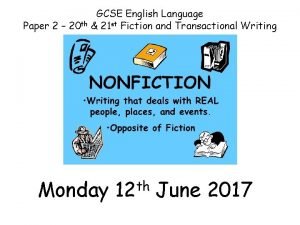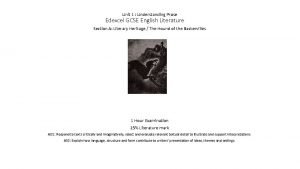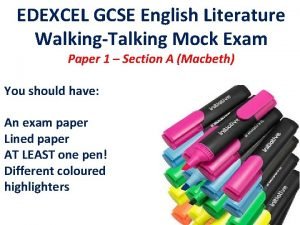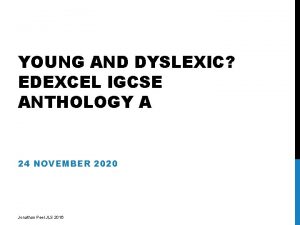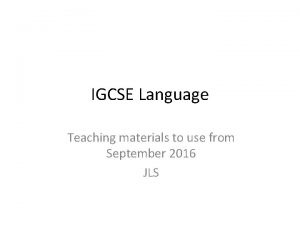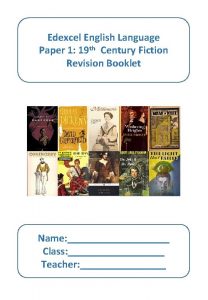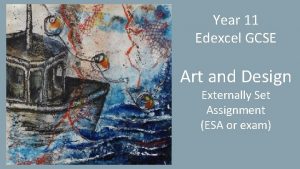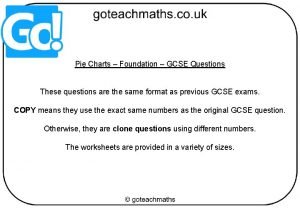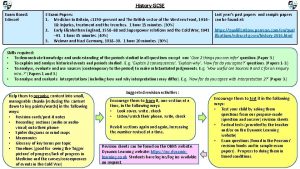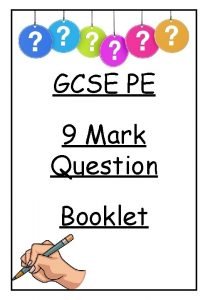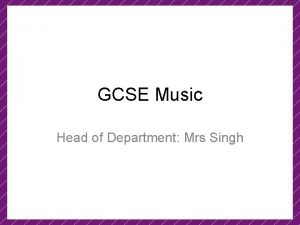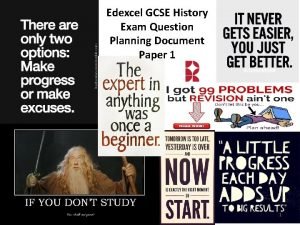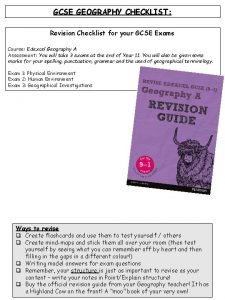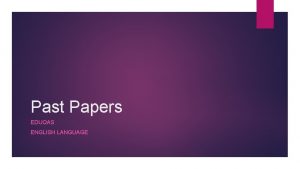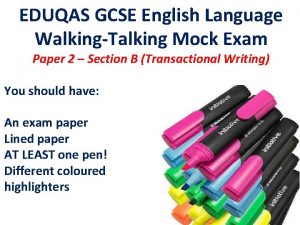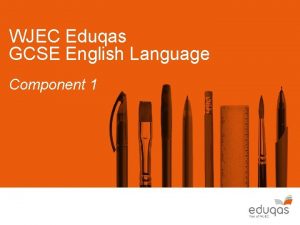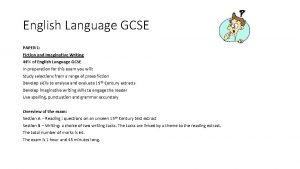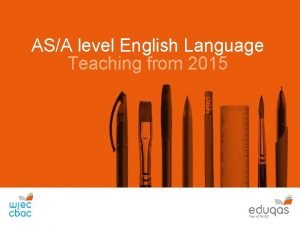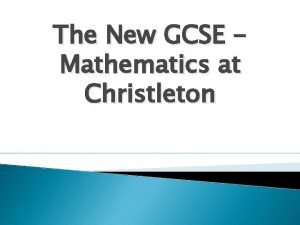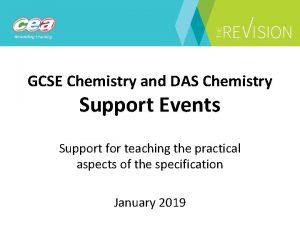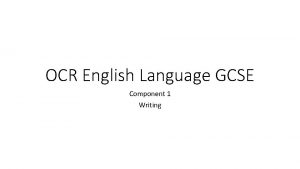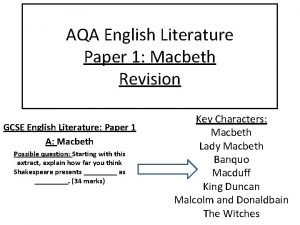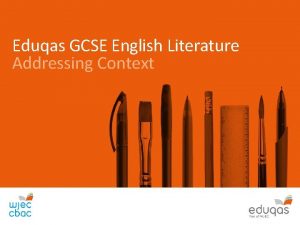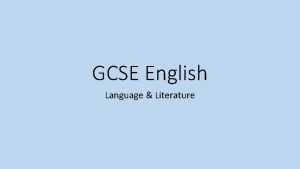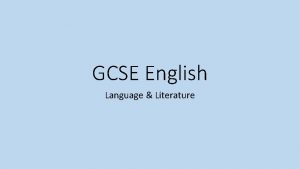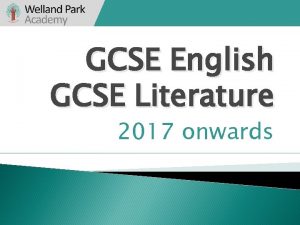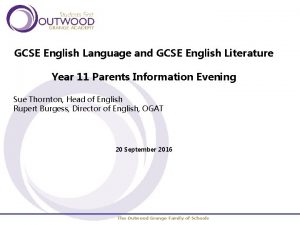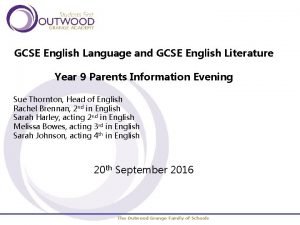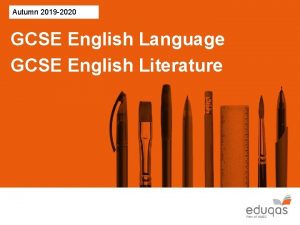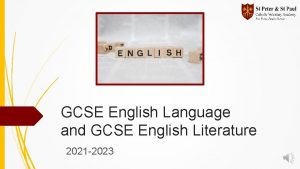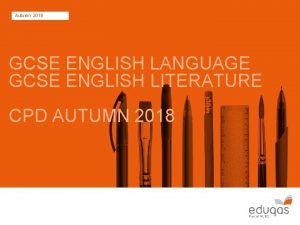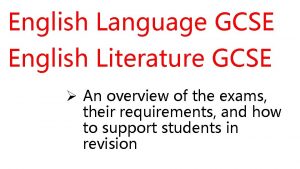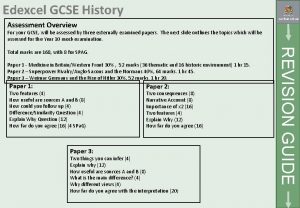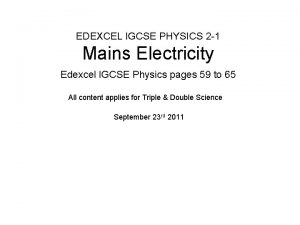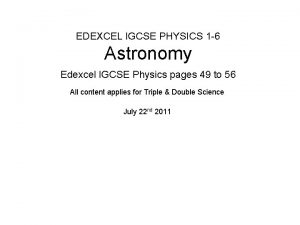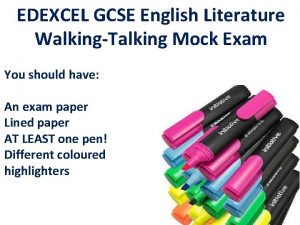Pearson Edexcel GCSE 9 1 English Language New






































- Slides: 38

Pearson Edexcel GCSE (9 -1) English Language: New to Edexcel Presentation Title Arial Bold 7 pt 1

Image by Photographer’s Name (Credit in black type) or Image by Photographer’s Name (Credit in white type) Aims and Objectives Delegates will: - Be given an overview of the specification - Be supported in starting to teach Edexcel English Language 2

GCSE English Language: Overview of the specification

Changes to subject criteria GCSE English Language • Reading - 50% of the GCSE – Students are required to answer questions on unseen 19 th, 20 th and 21 st century texts – These texts must cover fiction, non-fiction and literary nonfiction • Writing - 50% of the GCSE – SPa. G has an increased weighting of 20% 4

Changes to subject criteria Spoken Language endorsement • Speaking and Listening is renamed as Spoken Language and assessed as a separate endorsement • Students will be required to present to an audience a topic of their choice and listen to, and answer, questions • Students’ presentations will be recorded and sent to the Awarding Body for moderation • There are 2 assessment objectives: AO 7: Demonstrate presentation skills in a formal setting. AO 8: Listen and respond appropriately to spoken language, including to questions and feedback to presentations. 5

GCSE English Language 6

Key Features 7

Key Features 8

Key Features 9

Key Features 10

Assessment for Reading and support

GCSE English Language Assessment objectives for Reading 12

How are the assessment objectives assessed? • AO 1 is assessed in the first short questions on Paper 1 and Paper 2; it is also assessed via a ‘synthesis’ question in Paper 2 • AO 2 is assessed in Q 3 of Paper 1 and Q 2, Q 3, Q 5 of Paper 2 • AO 3 is assessed in Q 7 b of Paper 2 • AO 4 is assessed in Q 4 of Paper 1 and Q 6 of Paper 2 13

Example of AO 1 assessment Paper 1 Q 2: From lines 13 -19, give two ways the narrator’s behaviour shows that he is confident he will not be caught. Question 2 Mark Comments 1. 'I smiled, for what had I to 2 This candidate gives two quotations to answer fear' the question which is acceptable. 2. 'wild audacity of my perfect triumph' 1. Covered up the evidence by placing a chair on top of the corpse 2. He was confident. Not insecure. 1. He smiled and welcomed the gentlemen into his home. 2. He showed the men around and sat down with them. 1 This answer achieves one mark for the first point but the second is not specific enough to achieve a mark. 2 This candidate has used their own words to answer the question which is acceptable. The first answer could be credited as two points (smiled and welcomed). 14

How can students approach these questions in the classroom? • These questions are essentially retrieval questions – they ask for explicit pieces of information from explicit lines. • Students can use either their own words or direct quotations therefore it might be a good idea to encourage students to learn both approaches. • There is no need to write anything ‘extra’ therefore students need to practise reading the question carefully, locating the relevant lines, reading that section carefully and extracting the relevant pieces of information. 15

AO 2 assessment – an extract Paper 1 Q 3: In lines 12 -29, how does the writer use language and structure to show the narrator’s thoughts and feelings? The writer shows that the narrator feels intrigued by the woman. He ‘looked attentively’ which he wants to understand here because the adverb ‘attentively’ has connotations of being eager to learn and alert. The writer also tells the reader that it was ‘nearly one o’clock’ and by presenting this information in a short sentence, he suggests the narrator feels it is a surprising fact that she is out at this time…. 16

Language and Structure • In these questions, students need to ensure that they are selecting both language and structure features as well as answering the question. • It is not enough to simply list the features that the writer uses, they will need to show the writer uses these features. • It is always worthwhile reading the indicative content from the SAMs and the specimen papers carefully as they are a good guide to see what is meant by language and what is meant by structure. • As with AO 1, students need to practise reading the question carefully, locating the correct lines and picking out the relevant language and structure features in timed conditions. 17

AO 4 - evaluate • The introduction of this new assessment objective which requires students to ‘Evaluate’ has raised many questions since the specifications have been developed. • We have therefore developed a lot of support and run networks to explain how this new AO will work and how you can support your students in the classroom. • The key to success in AO 4 is that students need to: - focus on ‘how well’, not ‘how’ - use evaluative language and offer an opinion or judgement - focus on settings, ideas, themes and/or events. 18

AO 4 vs AO 2 • A key lesson which came out of our production of student exemplars was that students tended to give an AO 2 rather than an AO 4 response. • Therefore, a useful starting point might be to compare the two AOs with the students. AO 4: Evaluate texts critically and support this with appropriate textual references AO 2: Explain, comment on and analyse how writers use language and structure to achieve effects and influence readers, using relevant subject terminology to support their views 19

AO 4 - evaluate • A quick ‘ice breaker’ exercise which has worked well in the classroom is to ask students to evaluate either some pictures, what they watched on TV, the latest computer game etc. in pairs. • Once they have done this for a couple of minutes, they will realise that they have made a judgement, been positive or negative and reflected on their own needs and/or those of other audiences. • This is exactly what they need to do when they evaluate texts – they need to look at the overall bigger ideas and think about how successfully the writer has achieved the intended purpose of the text. 20

AO 4 - SITE • One way to approach AO 4 both in the classroom and in the assessment could be encourage students to think about SITE when looking at the texts. • This means they need to consider Setting, Ideas, Theme and Events. • These 4 big headings encourage students to move away from the pinpoint analysis required for AO 2 and to look at the overall success of a text. • REMEMBER: students do not always have to 100% agree that the writer was successful in putting across the purpose of the text. However, they must use evidence and evaluative language to justify their reasons. 21

AO 4 – Crafting a response 22

AO 1 – Synthesis • This final element of AO 1 is assessed through a discrete question in Paper 2 - 7 a). • Students need to draw information from both texts. • This is not a comparison (AO 3) as students select explicit information from both texts. • It is therefore similar to the early retrieval questions but students need to do it across two texts. 23

AO 1 – Synthesis – an extract Paper 2 Q 7 a): The two texts show people experiencing change. What similarities do the writers share in these extracts? Use evidence from both texts to support your answer. Both writers describe a downgrade in space for their belongings. Text 1 narrates a downgrade to a ‘thirty by seventy centimetre’ space, whilst Text 2 is to a house with ‘two small but shipshape bedrooms’ Both use rhetorical questions to engage the reader with the change. Text 2 uses direct address also in the question ‘A bit said, you say? ’ and this is reflected in Text 1’s ; you’re taking a tracksuit? ’. The effect of this is to involve the reader, emphasising the emotions of change… 24

AO 3 – Comparison • Comparison of two texts has been a key part of the current GCSE • The comparison will feature in Paper 2 and will therefore be on the non-fiction texts • Ideas, perspectives, language, structure • It will be the final question – as by then candidates will have selected and synthesised, examined language and structure and evaluated texts – they will know the texts very well. 25

AO 3 – Comparison – an extract Paper 2 Q 7 b): –Compare how the writers of Text 1 and Text 2 present their ideas and perspectives about possessions. …One of the most noticeable differences between the two texts is that the discarding and selection of possessions in text 1 are ‘forceful, necessary’ and that text 2’s is optional and by choice. This arises from the setting of each extract – the first text is set in a prison whereas the second is a move from a more comfortable ‘huge basement library’ with ‘three bedrooms plus guest flat’ to ‘two small but shipshape bedrooms’. As a result, it is unsurprising there are differences in ideas… In addition, the first text has a more cynical tone, factual and unrelenting. It is in the back-drop that the harsh reality of the lack of possessions in presented (first five books). The second has a more motherly yet humorous tone, which provides a more positive tone… 26

Synthesis vs Comparison 7 a asks students to synthesise • 7 b asks students to compare material from the two texts: 1. the question will always ask for points of similarity between concrete ideas, such as people or places 1. the question is always about presentation of ideas and perspectives in the texts – which could be similarities and differences 27

Assessment for writing and support

GCSE English Language Assessment objectives for Writing 29

Imaginative Writing – an extract • Paper 1 Q 5: Write about a time when you met somebody new. Your response can be real or imagined. You may wish to base your response on one of the images. She was amazing. She was stunning. She was potent. She was the girl of my dreams and I wanted nothing more than her. She was perfect. My vivid and deluded imagination had left me with only one problem: I had never spoken to her. Until now The night of the party, it was raining. Heavily. It foretold me what was to come. I entered the house and the explosion of sounds resounded throughout my body… 30

Support

What support can I receive? • Example papers: There are 3 sets of specimen papers on the website for Paper 1 and Paper 2, complete with mark schemes, plus the 2017 live papers. • Exemplars: There are exemplars for every level for every question for Paper 1 and Paper 2, with some full paper responses. • Unseen preparation anthology: There is an anthology with 8 fiction texts and 8 pairs of non-fiction/literary non-fiction texts. • Support for reading unseen texts: The ‘Let’s think in English’ resources are useful here. 32

What support can I receive? • Support for reading unseen texts: The ‘Let’s think in English’ resources are useful here • Support for writing and teaching grammar: There are 9 lessons from the ‘Grammar for Writing’ team to help you teach grammar and improve your students’ reading and writing • So. W and planners: For you to cut and paste and amend as needed • KS 3 tests – for Years 7, 8 and 9 • Mapping documents – if you are switching from another AB’s specification 33

Our website 34

Personal support English Subject Advisor, Clare Haviland: • teachingenglish@pearson. com • Tele: 0844 372 2188 • http: //www. edexcel. com/Subjects/English/Pages/Default. aspx • English forum look at and participate in: www. community. edexcel. com/english/default. aspx • Twitter: @Pearson. Teach. Eng • www. edexcel. com/learningforabetterfuture 35

Free and paid for training • • • Join a network event. These will be held in the Spring Term next year. Keep an eye on the website to see times, dates and locations. Book a visit from an English specialist by filling out the form on the website. These visits are free and the trainer can talk through any of the Network or Getting Ready to Teach materials with your department. Download our mocks marking packs – these can be found on the training from Pearson website. 36

Pearson Paid-For Published Resources • Pearson – Printed text book anthology; 6 tiered workbooks building reading and writing skills; Active Teach; assessment and revision resources. • For more information, visit the Pearson website 37

There’s so much more to learn Find out more about our range of events at http: //qualifications. pearson. com/training
 English literature a level edexcel past papers
English literature a level edexcel past papers Pearson unseen material
Pearson unseen material English language gcse edexcel
English language gcse edexcel Aqa eng lang paper 2
Aqa eng lang paper 2 Edexcel gcse english literature
Edexcel gcse english literature Macbeth edexcel past papers
Macbeth edexcel past papers English language paper 2 edexcel
English language paper 2 edexcel Young and dyslexic
Young and dyslexic Beyond the sky and the earth igcse text
Beyond the sky and the earth igcse text Edexcel english language paper 1 dracula
Edexcel english language paper 1 dracula Gcse art assessment objectives edexcel
Gcse art assessment objectives edexcel Pie charts gcse
Pie charts gcse Edexcel past papers history
Edexcel past papers history Gcse pe 9 marker structure
Gcse pe 9 marker structure Edexcel gcse music set works
Edexcel gcse music set works Edexcel music gcse
Edexcel music gcse Edexcel gcse drama
Edexcel gcse drama Edexcel gcse pe specification
Edexcel gcse pe specification Edexcel gcse history crime and punishment past papers
Edexcel gcse history crime and punishment past papers Gcse geography edexcel b revision checklist
Gcse geography edexcel b revision checklist Ruby lennox mark scheme
Ruby lennox mark scheme Eduqas gcse english language past papers
Eduqas gcse english language past papers Eduqas gcse english language
Eduqas gcse english language The lovely bones gcse english
The lovely bones gcse english English fiction and imaginative writing
English fiction and imaginative writing 2011 pearson education
2011 pearson education 2011 pearson education inc
2011 pearson education inc Bob whelan pearson
Bob whelan pearson Stress management for life 5th edition
Stress management for life 5th edition Pearson education inc publishing as pearson prentice hall
Pearson education inc publishing as pearson prentice hall Pearson education inc publishing as pearson prentice hall
Pearson education inc publishing as pearson prentice hall 2008 pearson prentice hall inc
2008 pearson prentice hall inc Levels of language knowledge
Levels of language knowledge New gcse grades
New gcse grades Gcse grades percentage equivalents
Gcse grades percentage equivalents Physics grade 9 unit 3
Physics grade 9 unit 3 Language book
Language book Aqa english literature paper 1 macbeth
Aqa english literature paper 1 macbeth Unseen poetry eduqas
Unseen poetry eduqas



